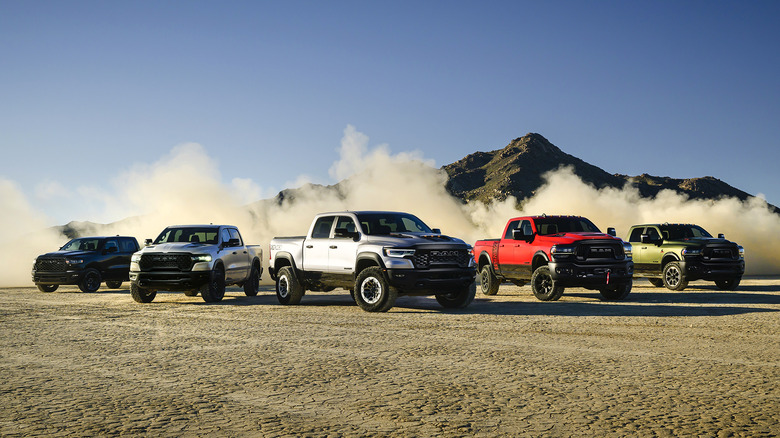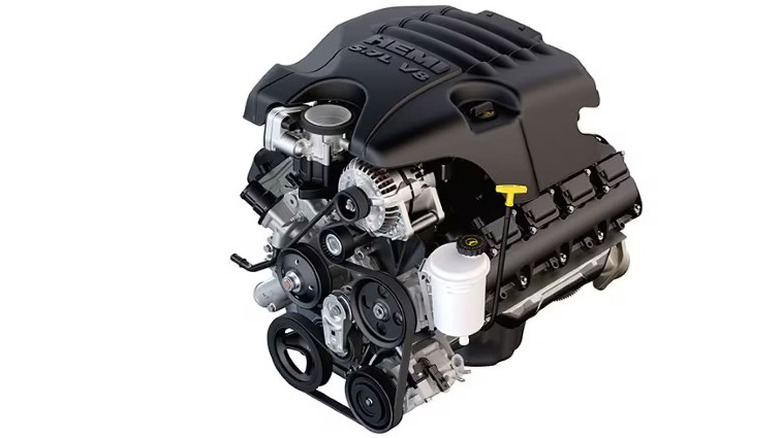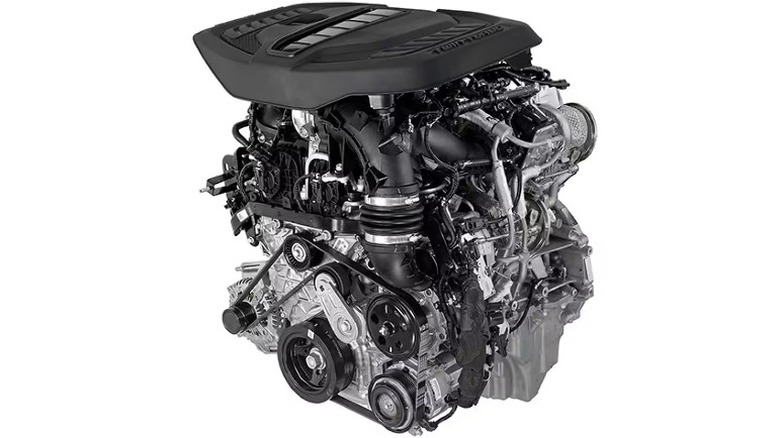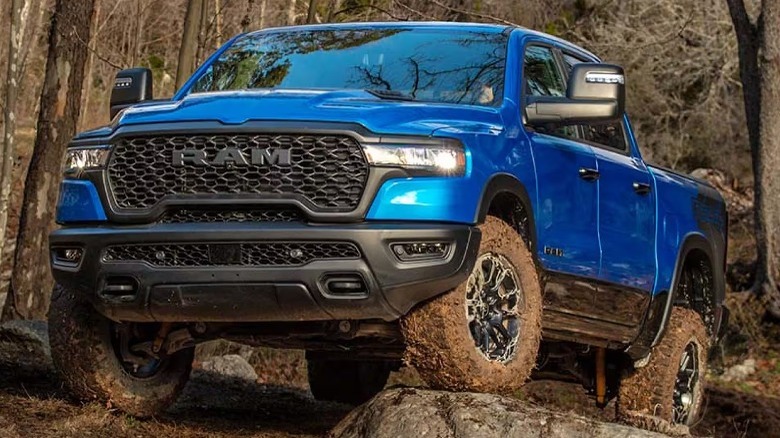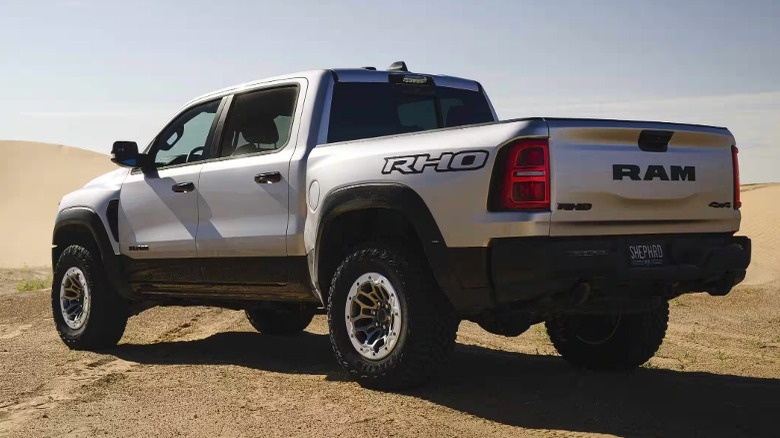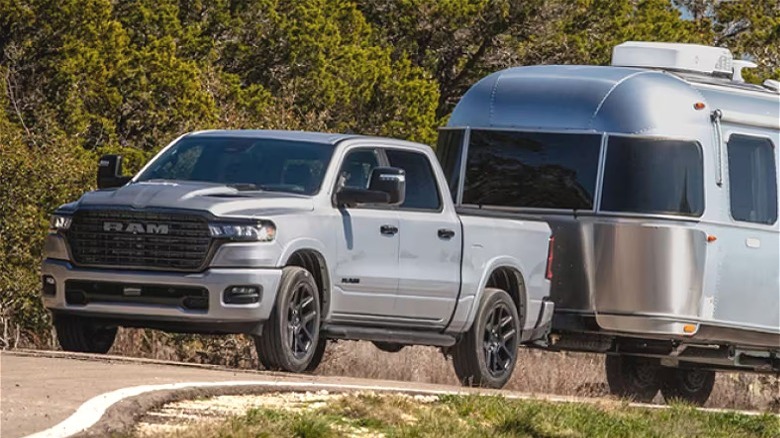RAM Hurricane Engine Vs. Chrysler HEMI V8: What's The Difference?
The Ram 1500 truck has featured a choice of several engines over its lifespan, but one of the most celebrated (and marketed) has been the powerful V8 HEMI. The HEMI engine went through three generations of design, with the most recent version of the Gen III — a 5.7-liter with variable cam timing (VCT) — unveiled in 2009 with better fuel economy and power. That variable timing optimizes cylinder firing in all gears, providing torque for towing but also reliable horsepower throughout the rpm range.
As the HEMI has aged, emissions standards have gotten stricter, and for the 2024 model year, this engine was phased out. The Ram 1500 replaced it with the Hurricane, a new, smaller engine. The Hurricane engine has six cylinders and two turbochargers — each turbocharger boosting three cylinders.
Let's look at how these two engines differ and how their horsepower, torque, and design affect the 1500 model's performance in fuel economy and towing capacity.
The Chrysler 5.7L HEMI V8 engine
The legendary HEMI has been around for a long time, powering many vehicles such as Ram trucks, Jeeps, and Dodge Challengers. It entered its third generation in 2003 under the hood of the Dodge Ram 1500, 2500, and 3500 pickup trucks.
The last HEMI to appear in the Ram 1500 — still a Gen III but updated in 2009 — was a 5.7L V8 that produced 395 horses and 410 lb-ft of torque. It was in 2009 that the HEMI was redesigned with variable cam timing (VCT) to increase fuel efficiency, among other things. It also gained better cylinder heads and crankshaft for heavy use.
An eTorque version of this HEMI was available in the Ram 1500 into the 2024 model year. It offers the same horsepower and torque with an added advantage of incorporating regenerative braking, which uses the heat energy from braking to power the truck's electrical systems. It also provides 130 lb-ft of available extra torque that boosts the towing capacity and features Engine Stop/Start Technology that bumps up fuel economy and reduces greenhouse gas emissions.
The Ram 3.0L Hurricane I6 engine
Beginning in 2025, Ram introduced the Hurricane engine to the 1500 pickup, as an alternative to the Pentastar V6 — also available in the 2025 model 1500. The Hurricane is manufactured by Stellantis, the parent company of Jeep, Dodge, and Ram, which is why these three brands are all using it.
The Hurricane SO (standard output) Twin Turbo is a 3.0L inline-six engine. Like the eTorque version of the 5.7L HEMI, it also features Engine Stop/Start Technology for better fuel economy and fewer emissions. Buyers might worry that fewer emissions equals less horsepower, but the Hurricane boasts 420 horsepower and 469 lb-ft of torque.
The Hurricane comes in a High-Output version, too, pushing horsepower up to 540 and increasing torque to 521 lb-ft. According to Ram, the 2025 1500 RHO with this engine will give drivers more standard horsepower than the Ford Raptor. The HO version outpowers the previous Ram 1500 HEMI by 145 horsepower and 111 lb-ft of torque.
Which engine has better fuel economy?
Buyers of large trucks with internal combustion engines (ICE) already know they will be spending more than the average car owner at the pump. With each generation vehicle, automakers strive to improve fuel efficiency based on the requirements of government regulations that help save drivers money on gas. But is newer always better?
The U.S. Department of Energy and the U.S. Environmental Protection Agency have a website showing the results of standardized tests of the fuel economy for many vehicles. In a side-by-side comparison of 4WD Ram 1500s, testing showed that the standard-output turbo Hurricane 3.0L six-cylinder with automatic eight-speed transmission in the 2025 Ram scored a combined 19 mpg, with 17 mpg city driving and 24 mpg on the highway. The high-output turbo Hurricane 3.0L six-cylinder with automatic eight-speed transmission for the same model year scored a combined 17 mpg, with 15 mpg city driving and 21 mpg on the highway. The 5.7L eight-cylinder HEMI in a 2024 Ram 1500 4WD with automatic eight-speed transmission tested at a combined 19 mpg, with 18 mpg city and 22 mpg highway.
Based on its mileage testing, the EPA estimates annual petroleum consumption (where one barrel equals 42 gallons of gasoline) for each vehicle. The EPA listed the HEMI running on midgrade gasoline as consuming 15.7 barrels in a year. The standard output Hurricane running on regular gasoline would use 15.7 barrels. And the high-output Hurricane running on premium gasoline would drink 17.5 barrels.
If the Hurricane is touted as a fuel-efficient engine, why does it struggle to compete with the HEMI in real-world gas usage? The answer may lie in the fact that the 2024 HEMI is a semi-hybrid thanks to its eTorque, which helps the truck from a dead start -– an electric benefit the Hurricane does not currently offer.
Which engine has fewer emissions?
EPA testing also reveals much about the tailpipe emissions of the Ram 1500's last HEMI and first Hurricane engines. The emissions testing measures the amount of greenhouse gases (GHG) coming from each vehicle, which is mostly carbon dioxide (CO2). Why care about what the drivers, too, are exhaling? Because of concerns that excess CO2 plays a role in climate change as a prominent greenhouse gas.
The EPA stated that the standard-output Hurricane was found to emit 458 grams of GHGs per mile. The high-output Hurricane emitted 521 grams per mile. The HEMI — likely once again thanks to eTorque technology (aka a hybrid boost) — rocked 456 grams per mile in these tests.
As a point of comparison, a typical AWD passenger car such as a Toyota Camry XLE with a 2.5L four-cylinder engine produces 315 grams per mile of greenhouse gases and uses 10.6 barrels of gas annually.
Which engine has better towing capacity?
Since one of the main reasons people buy trucks is to haul around things like boats and trailers, maximum towing capacity is a key factor in the purchasing decision. So, how did the switch from HEMI to Hurricane affect the Ram 1500's towing capacity?
The standard-output Hurricane engine offers a maximum towing capacity of 11,550 pounds. Although the high-output Hurricane engine has more horsepower, it has even less towing capacity — 9,920 pounds.
The discontinued 5.7L HEMI V8, standard edition, featured a respectable towing capacity of 11,610 pounds. However, the hybridized HEMI with eTorque trumps them all by featuring a whopping 12,750 pounds of towing capacity.
While the HEMI has had its good and bad years throughout its life in the Ram 1500, it's interesting to note that in its last generation, it still manages to hold up impressively when compared to the new Hurricane despite numerous differences in design.
